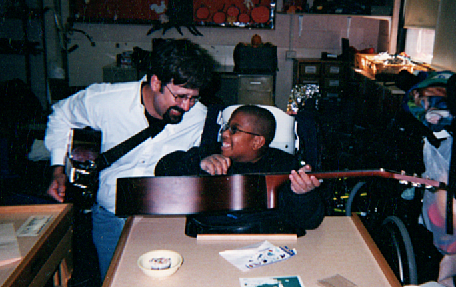When I was a college music major, I didn’t give a thought about sitting practices in the music room.
Neither did any of my instructors.
But I changed.
Within three days of the start of my first full-time general music gig in a tony private day school, I knew that I needed my music students sitting in chairs and not on the floor.
How do have kids sit in your classes?
I've learned that if I can get kids to properly sit in chairs in an elementary school, they will usually perform, think, and demonstrate the attitude of someone at least one or two grades above where they are.
Unfortunately, chairs are not always possible. Sometimes there are just not enough chairs in a school.
At my last school, I used to borrow chairs from the multi-purpose room.
The floors and the carpets in schools are generally filthy and germ-laiden. Younger children have a way of having soiled their pants, and there's no way to stop that from seeping into a rug.
Even if there were music room chairs available, we would start the year with the chairs stacked in the back of the room.
My students would have to repeatedly demonstrate that they were ready to sit in chairs. That meant they had to be able to handle sitting in rows on the floor for at least two weeks.
After that we would add the chairs. And if their management of chairs started to slip, I could suggest that maybe we need a sitting refresher on the rug.
As far as playing guitar in elementary schools, chairs are a must for kids. The exception is kindergarten where start strumming with guitars that are flat on the floor.
By the way, I never bought 1/2 size or 3/4 size guitars. I always purchased full-sized dreadnaughts, knowing that kids aren't going to get any smaller; they're only going to get bigger and grow into the instrument.
Don’t even talk to me about ukuleles.
Extended sitting on the floor can be painful for a child. If kids have to sit on the floor, they need to be up and about at least every seven or eight minutes. “Go time” breaks in my room always included the freedom to talk and walk around the room.
When I first started directing middle school chorus , sitting practices were a low priority for a few months – I had my hands full.
But I changed.
Choral rehearsals always required chairs. We would stand about one-third of the rehearsal. We had three seating positions:
Seated position three, where we sat in a more relaxed way as if we were in a classroom, restaurant, or movie theater.
Seated position two, where we sit “up straight” with our backs against the chair and our feet flat on the floor.
Seated position one, where we sat with our back away from the chair, our bottoms closer to the front of the seat, and our feet flat on the floor.
Seated position three was where we were most of the time in our rehearsals.
I should have been more of a stickler about sitting – but I wasn’t.
Or about kids walking a little too fast in the hallway. I let that slide, too.
Or about kids wanting to talk to their friends in class. That’s why they had “Go time”.
Optimally, change comes through the experience of empathy.
Ultimately, change comes through the experience of being in the room.
You change once you experience hundreds of kids who are strapped into chairs with wheels.
You change once you experience kids with no ability to ambulate on their own.
You change once you experience kids who struggle to make themselves understood.
You change.
And you discover a world of appreciation that you never knew existed.
And while we can’t change the world, we can approach our little acre and endeavor to make it better for those who inhabit it through music.
When you are beyond frustrated with the behaviors of a kid, take a beat, and remind yourself that they can change for the better.
It might not be on your watch. It may be way down the road.
But every little bit of positive encouragement we provide will add to future encouragement and lead to change in your students.
You can change.
Your students can change.
And in the hands of positive, proactive people, change can be good.
Neither did any of my instructors.
But I changed.
Within three days of the start of my first full-time general music gig in a tony private day school, I knew that I needed my music students sitting in chairs and not on the floor.
How do have kids sit in your classes?
I've learned that if I can get kids to properly sit in chairs in an elementary school, they will usually perform, think, and demonstrate the attitude of someone at least one or two grades above where they are.
Unfortunately, chairs are not always possible. Sometimes there are just not enough chairs in a school.
At my last school, I used to borrow chairs from the multi-purpose room.
The floors and the carpets in schools are generally filthy and germ-laiden. Younger children have a way of having soiled their pants, and there's no way to stop that from seeping into a rug.
Even if there were music room chairs available, we would start the year with the chairs stacked in the back of the room.
My students would have to repeatedly demonstrate that they were ready to sit in chairs. That meant they had to be able to handle sitting in rows on the floor for at least two weeks.
After that we would add the chairs. And if their management of chairs started to slip, I could suggest that maybe we need a sitting refresher on the rug.
As far as playing guitar in elementary schools, chairs are a must for kids. The exception is kindergarten where start strumming with guitars that are flat on the floor.
By the way, I never bought 1/2 size or 3/4 size guitars. I always purchased full-sized dreadnaughts, knowing that kids aren't going to get any smaller; they're only going to get bigger and grow into the instrument.
Don’t even talk to me about ukuleles.
Extended sitting on the floor can be painful for a child. If kids have to sit on the floor, they need to be up and about at least every seven or eight minutes. “Go time” breaks in my room always included the freedom to talk and walk around the room.
When I first started directing middle school chorus , sitting practices were a low priority for a few months – I had my hands full.
But I changed.
Choral rehearsals always required chairs. We would stand about one-third of the rehearsal. We had three seating positions:
Seated position three, where we sat in a more relaxed way as if we were in a classroom, restaurant, or movie theater.
Seated position two, where we sit “up straight” with our backs against the chair and our feet flat on the floor.
Seated position one, where we sat with our back away from the chair, our bottoms closer to the front of the seat, and our feet flat on the floor.
Seated position three was where we were most of the time in our rehearsals.
I should have been more of a stickler about sitting – but I wasn’t.
Or about kids walking a little too fast in the hallway. I let that slide, too.
Or about kids wanting to talk to their friends in class. That’s why they had “Go time”.
Optimally, change comes through the experience of empathy.
Ultimately, change comes through the experience of being in the room.
You change once you experience hundreds of kids who are strapped into chairs with wheels.
You change once you experience kids with no ability to ambulate on their own.
You change once you experience kids who struggle to make themselves understood.
You change.
And you discover a world of appreciation that you never knew existed.
And while we can’t change the world, we can approach our little acre and endeavor to make it better for those who inhabit it through music.
When you are beyond frustrated with the behaviors of a kid, take a beat, and remind yourself that they can change for the better.
It might not be on your watch. It may be way down the road.
But every little bit of positive encouragement we provide will add to future encouragement and lead to change in your students.
You can change.
Your students can change.
And in the hands of positive, proactive people, change can be good.


 RSS Feed
RSS Feed